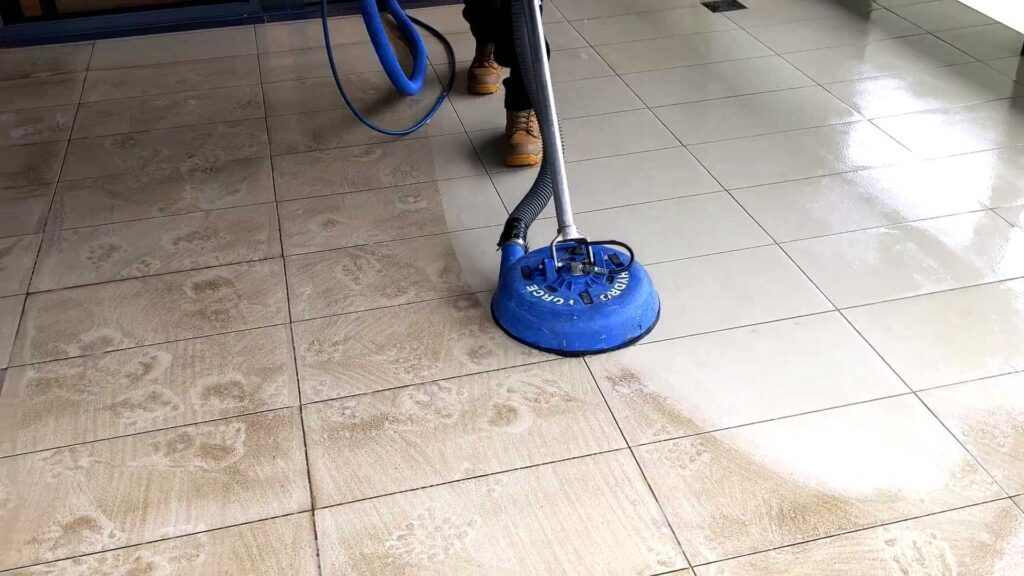Table of Contents
Are your floors looking dull and grimy? Are you tired of scrubbing endlessly to no avail? Well, fear not! We have the ultimate guide to help you master the art of tile and grout cleaning. Whether it’s in your bathroom, kitchen, or any other tiled area, we’ve got all the tips and tricks you need to make those tiles sparkle like new again. Say goodbye to dirt and hello to a cleaner, fresher space. Prepare for profound satisfaction as we delve deep into tile and grout cleaning!

What is Tile and Grout Cleaning?
Tile and grout cleaning is a service that needs to be done regularly to keep the flooring looking clean and fresh. Using the right products and techniques for the job is essential, or you could end up with a mess.
Tile and grout cleaning aims to remove dirt, dust, pet hair, construction debris, oil soils, mold spores, food residues, limescale build-up, etc., from between tiles and grout joints. It will restore your tile/grout surfaces to their original condition to repel moisture and make them look shiny new again!
There are many ways to clean your tile/grout surfaces:
- Manual scrubbing with a brush or mop
- Machine scrubbing with a rotary scrubber
- Heat disinfection with steam (where necessary)
- Using one of several specialized cleaners, such as power washers or ultraviolet light systems
The most important factor when choosing a method is to use one that will safely remove all of the embedded dirt, oils, waxes, bacteria cells, and other contaminants from your tile/grout surfaces.
Types of Tile and Grout Cleaning

Tile and grout cleaning can be daunting, but it can be done quickly with the right tools and techniques. Here are four types of tile and grout cleaning:
1. Steam Cleaning – This type of cleaning uses hot water and steam to remove dirt, dust, and bacteria from tiles and grout.
2. pressure washing – This type of cleaning uses high-pressure water to loosen dirt, debris, and bacteria from tiles and grout.
3. Chemicals – Some chemicals are designed to clean tile and grout surfaces. These cleaners often contain acids or solutions that cause damage if left on the surface too long, so use them cautiously.
4. Manual Cleaning – This is the most common type of tile and grout cleaning and involves using a brush or mop to scrub the surface clean.
The Process of Tile and Grout Cleaning
Tile and grout cleaning is a process that involves the removal of built-up dirt, dust, tile adhesive, and other debris. It can be essential to keep your home or workplace clean and organized. Here are some tips on how to get the most out of your tile and grout cleaning:
1. Start by assessing the condition of your tiles and grout. If they need repair or restoration, have that work done first? Otherwise, take a close look at the condition of the surface and identify any areas that appear dirty or damaged.
2. Test the suction power of your vacuum cleaner on an inconspicuous area first. You may need to increase the suction power if it isn’t removing much dirt or debris. Use floor protectors if your vacuum has them for maximum protection against scratches on flooring surfaces.
3. Once you have determined how much suction power is necessary, begin vacuuming along the edges of each tile and grout line. Be careful not to overreach – pulling too hard can damage tiles or disturb adhesives.
4. Use a broom handle to dislodge smaller objects (like pieces of paper) between tiles; larger objects can be removed using a bucket and mop combination. Ensure to rinse off all debris after each sweep so that it doesn’t accumulate on the flooring again.
5. If you notice any spots or areas where debris still needs to be removed completely, use a scrub brush to work the dirt and debris into the grout lines. Be careful not to damage the tile surface or the grout – use moderate pressure and work from the top down.
6. Once all of the dirt and debris has been removed, apply a sealant to any newly cleaned areas and let it dry thoroughly. You can also opt for professional tile and grout cleaning – this will usually include deeper cleaning of all nooks and crannies and sealing to prevent future dirt and debris accumulation.
Tools and Materials Required for Tile and Grout Cleaning

Tile and grout cleaning can be daunting, but with the right tools and materials, it can be easy. Here are the basics you’ll need:
– A hose attachment for your water spigot is essential for wetting down the surfaces you will be cleaning.
– Swiffer or mop – A soft cloth or pad to clean surfaces – You’ll also want this to eliminate any excess water residue.
– Trowel – For dragging dirty areas away from the tile and grout.
– Gritty sandpaper or pumice stone – To rough up dirty areas and remove embedded dirt and debris.
– Lye soap – For attacking hard to reach spots on tiles and grout.
– Bucket or large container for containing lye solution – Keeps things safe while you work.
– Newspaper or non-abrasive cloth to wipe down surfaces after cleaning – Gives them a fresh start before you put anything back down.
How to Choose the Right Cleaner for Tile and Grout
When cleaning the grout and tile in your home, there are a few things to keep in mind. First, try to identify the type of cleaner that is best suited for the job. Second, ensure the cleaner you choose is safe for use on tile and grout surfaces. Be sure to read the instructions that come with your cleaner before using it.
Method of Cleansing Tile and Grout
Tile and grout cleaning can be an arduous process if not done correctly. The key to a successful tile and grout cleaning is to follow these six steps:
1. Remove any furniture, rugs, or plants from the floor before beginning. It will help speed up the process and protect your flooring from water damage.
2. Use a mop or bucket with soapy water and a hard-bristled brush to scrub the floor surface clean. Make sure to rinse off the soap residue after each stroke.
3. Wet the area you want cleaned with cool water and sprinkle ¼ cup of oven cleaner per gallon of water onto the wet surface. Mix well and then pour mixture over tile and grout area using a spray bottle or cloth mop. Scrub surfaces with the paste-like cleaner using a scrubber sponge. Work in circles to cover all areas. Rinse off the product mixture with water until all surfaces are clean.
4. Allow the area to dry for at least one hour before attempting to deep-clean the tile or grout.
Conclusion
Tile and grout cleaning can be daunting, but with the right tools and guidance, it can be a relatively simple process. Following our guide, you should be able to clean your tiles and grout effectively and quickly without spending much time or money. If you need help getting started, feel free to call us anytime; our friendly staff is more than happy to assist you. Thanks for reading!

